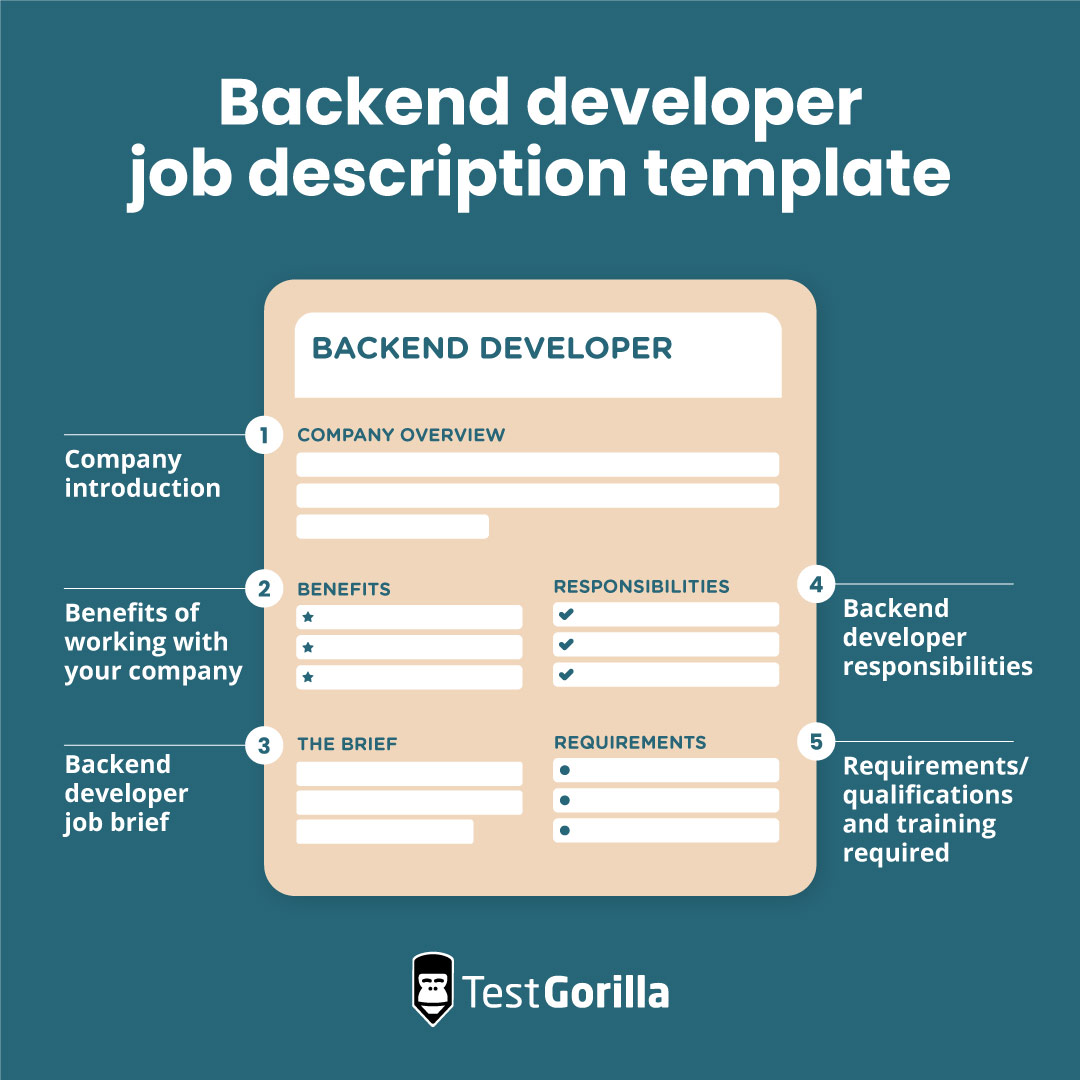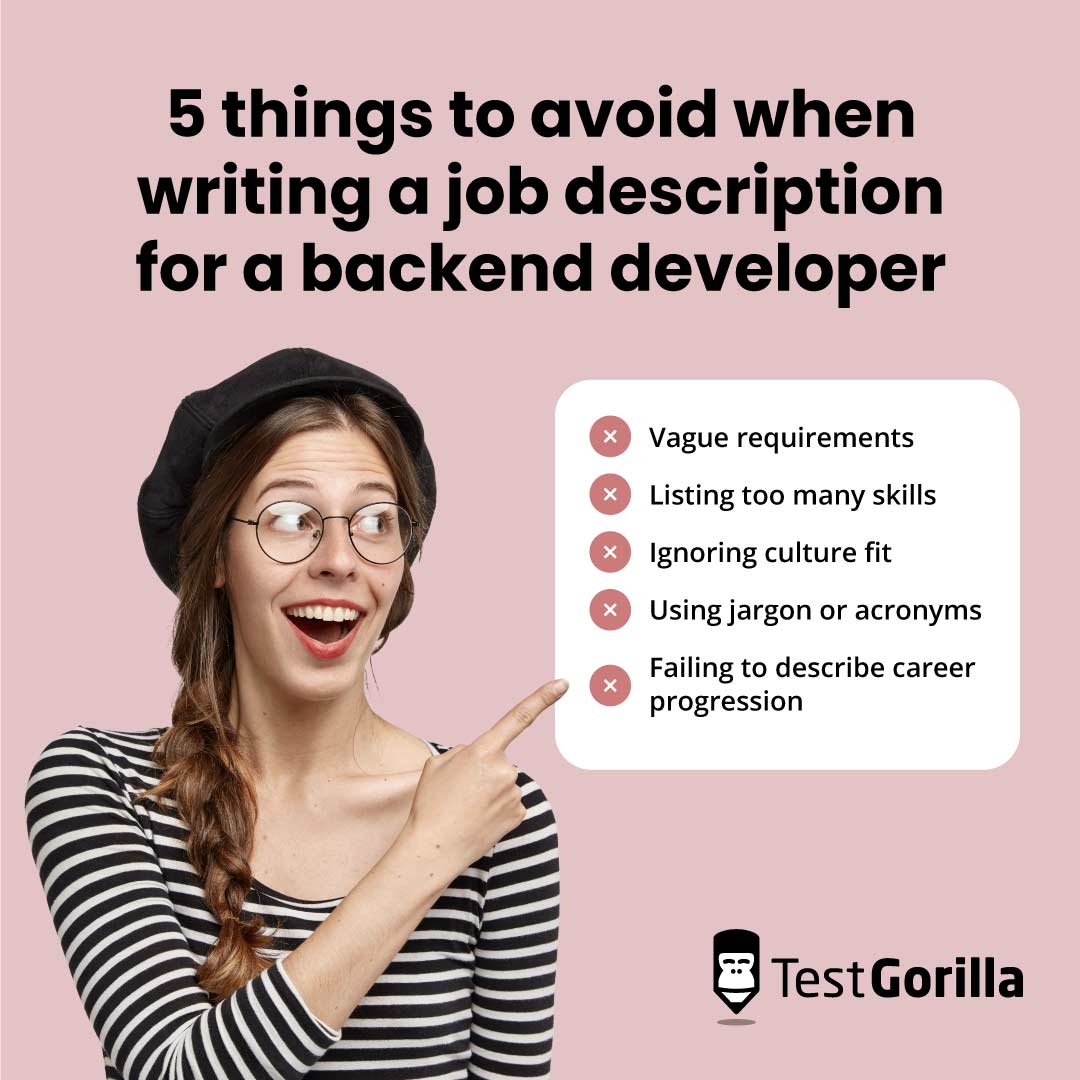Finding the right backend developer is a critical step in building web applications that are both powerful and secure. If your job description isn’t precise, you risk drawing in applicants who don’t meet your technical or cultural needs, taking up precious time and impacting your project’s success.
Crafting an accurate and enticing job description from the start is vital for attracting candidates who possess the technical skills to perform the job and the interpersonal skills to gel with your existing team and adapt to your company’s ethos.
This guide will assist you in creating a tailored job description aimed at capturing the attention of top-shelf backend developers. To make the task easier, we’ve also included a ready-to-use backend developer job description template.
Table of contents
- What is a backend developer?
- Key skills to look for in a backend developer
- How to write an effective backend developer job description
- Backend developer job description template
- Five things to avoid when writing a job description for a backend developer
- Next steps: Attracting and assessing backend developer candidates
- Backend developer job description FAQs
- Hiring the best backend developers with TestGorilla
What is a backend developer?
Backend developers are software engineers who focus on the server side of web applications.
While front-end developers create the visible parts of a website that users interact with, backend developers build and maintain the technology needed to power those front-end elements. This usually involves creating databases, Application Programming Interfaces (APIs), and server scripts.
Backend developers use a variety of programming languages like Java, Python, and Ruby, as well as database management systems such as MySQL or MongoDB.
Key skills to look for in a backend developer
The requirements for this role depend on the industry type and technologies used. For example, financial organizations may focus on security, while gaming companies value time to market, calling for different skill sets. However, there are core backend developer skills that span industries.
Programming languages: Familiarity with backend languages like Python, Java, and Node.js is often mandatory.
Database management: Know-how in handling SQL or NoSQL databases is a must for managing data efficiently.
Server management: Understanding server-side frameworks like Django, Flask, or Ruby on Rails can be beneficial.
Version control: Skills in Git or another version control system help maintain a streamlined development process.
Data structures: A firm grasp of algorithms and data structures can be invaluable.
RESTful API development: Experience developing and using REST APIs is often required.
Security measures: Awareness of cybersecurity best practices to protect data and system integrity.
Troubleshooting skills: Aptitude for critical thinking and problem-solving is highly useful.
Soft skills: Communication and teamwork skills are essential in any collaborative environment.
The best insights on HR and recruitment, delivered to your inbox.
Biweekly updates. No spam. Unsubscribe any time.
How to write an effective backend developer job description
Follow these steps to come up with an effective backend developer job description:
Research the role and its importance
Before you start writing, get to know the backend developer role and identify any skills gaps by gathering feedback from team members. They can offer unique perspectives on what qualities and skills are essential to fill the existing gaps and contribute effectively to the success of the project.
Decide on the compensation range
Be upfront about the salary range and benefits in the job description. This is important data for candidates and saves time for both parties.
Research average salaries for similar backend development roles and make sure your offer is competitive in your location or industry. According to Glassdoor, backend developers typically earn an average of $89,964 per year in the US.
Choose the right job title
Pick a job title that is both descriptive and consistent with industry standards. Misleading or fancy job titles can confuse candidates. Keep it straightforward with “Java Backend Developer” or “Senior Backend Developer” to make it easier for potential candidates to understand the level of the role.
Backend developer job description template
Use this template to guide your backend developer job description creation:
Company introduction
In this section, include a summary of your company’s mission, industry, and scale. Explain what sets your organization apart from competitors to pique the interest of developers. Highlight any major achievements or milestones your company has had. This helps potential backend developers feel they will be joining a winning team.
Benefits of working with your company
List the perks and benefits that come with the role, such as flexible work hours, professional development opportunities, or unique office amenities.
Specify any tech-specific advantages, like the chance to work with cutting-edge technologies or to contribute to high-impact projects. This attracts candidates looking for more than just a paycheck.
Backend developer job brief
[Company name]
Job Title: [For example, Junior PHP Backend Developer or Senior Ruby Backend Developer]
Reports to: [For instance, Head of Development or CTO]
Position type: [Full-time, part-time, on-site, remote, or hybrid]
[Salary and compensation details]
Backend developer responsibilities
Designing, building, and maintaining APIs and services
Collaborating with front-end developers to integrate user-facing elements with server-side logic
Writing reusable, testable, and efficient code
Ensuring the technical feasibility of UI/UX designs
Implementing security and data protection measures
Optimizing the application for speed and scalability
Monitoring system performance and troubleshooting issues
Staying current with industry trends and technologies
Backend developer requirements/qualifications and training required
Bachelor’s or master’s degree in computer science, software engineering, or a related field
Solid experience with backend programming languages, such as Python, Java, or Ruby
Proficient in database management (SQL, NoSQL)
Familiarity with server-side frameworks like Django, Ruby on Rails, or Node.js
Strong problem-solving skills and excellent attention to detail
Understanding of front-end web technologies like HTML, CSS, and JavaScript is a plus
[Other qualifications specific to your company’s needs]
Five things to avoid when writing a job description for a backend developer
Some common pitfalls can trip you up when writing a backend developer job description. Here’s what to steer clear of:
Vague requirements: Being unclear in your job description will only attract the wrong candidates. Instead of saying “familiar with databases,” specify which database technologies are important for the role, such as MySQL or MongoDB.
Listing too many skills: It’s easy to go overboard and list every possible skill. Doing so may deter potential candidates who don’t meet every criterion. Stick to the essentials.
Ignoring culture fit: While technical skills matter, don’t neglect to mention work environment or team dynamics. Emphasize what makes your company’s culture unique so you attract candidates who’ll mesh well with your team.
Using jargon or acronyms: Although you’re hiring for a technical role, keep the language simple. Not all backend developers will understand in-house terms or lesser-known acronyms. Adhering to standard industry language shows you follow best practices.
Failing to describe career progression: Most candidates want to know how they can grow within your organization. Without this information, you may lose out on candidates seeking long-term career opportunities. Briefly outline potential career paths for the role.
Next steps: Attracting and assessing backend developer candidates
After your job description is completed and posted to job boards, the next step in hiring a backend developer is effectively assessing the candidates you receive.
Using pre-employment tests, like those offered by TestGorilla, can provide an accurate gauge of both technical and soft skills.
Some tests to consider adding to your assessment include:
Personality tests, like the Enneagram or DISC
To avoid any potential bias, these tests should be your first filter, even before scrutinizing resumes or performing interviews. This skills-based multi-measure approach provides a well-rounded view of each applicant.
Backend developer job description FAQs
What are the typical responsibilities of a junior backend developer?
A junior backend developer usually focuses on writing clean, simple code under supervision. They help build APIs, database management, and basic server-side logic.
What technologies should a PHP backend developer have experience using?
A PHP backend developer should be proficient in PHP frameworks, like Laravel or Symfony, and skilled in database management systems like MySQL. An understanding of RESTful APIs and version control tools, like Git, is also important.
Hiring the best backend developers with TestGorilla
Creating a great backend developer job description attracts top talent to your candidate pool. The next step is to hire the best.
TestGorilla’s scientifically validated pre-employment tests give you a complete picture of your applicants, covering job-specific skills, cognitive abilities, and personality traits. Combine relevant tests for a bespoke assessment tailored to your backend developer role.
Sign up for TestGorilla’s Free plan and start hiring top-tier talent today.
You've scrolled this far
Why not try TestGorilla for free, and see what happens when you put skills first.

















